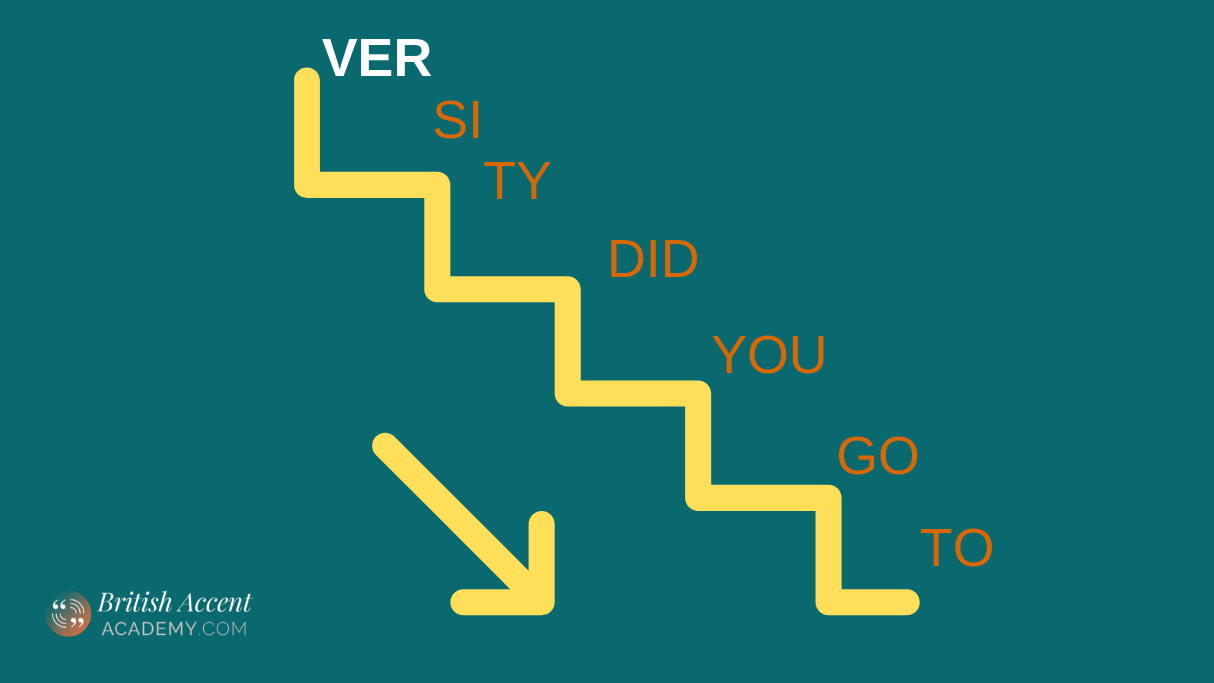
07 May Using Intonation To Show Genuine Engagement & Interest: Pronounce British English Like A Native Speaker
Enhancing engagement in English with high fall intonation
The mechanics of high fall intonation in British English
English is a stress-timed language. Each sentence is made up of chunks of speech (tone units), which carry stress and melody. A good example is: ˈthis is the ˈhouse that ˈJack ˈbuilt (Roach, 1982). We can see that some words are stressed: “this”, “house”, “Jack”, ” built”. We can also see that some words are unstressed: “is”, “the”, “that”. The most prominent word of all is “Jack” and this is the tonic syllable. The tonic syllable carries the main stress in the tone unit. The tonic syllable is often found within the final content word (noun, verb, adjective, adverb) in the tone unit and there might be unstressed words after the tonic syllable e.g. “which uniˈversity did you go to?”. Here, the tonic syllable is on /ˈvɜː/. All the syllables that follow the tonic syllable carry less stress than /ˈvɜː/. These words form the tail of the tone unit. Since we are falling, they get progressively lower in pitch.

The role of the tonic syllable and the tail in intonation
The tonic syllable is the longest and loudest syllable in the tone unit. Not only that, but it is also the beginning of the intonation pattern that will continue until the end of the tone unit. In the question “which university did you go to?”, the tonic syllable has a higher pitch than “which uni” and then we see a drop in pitch for each word that comes after “ver”. The pitch drops a little bit on “si”, then a bit more on “ty”, and so on, until we get to the final word in the tone unit, which is “to”. By the end of the tail, our pitch is at its lowest point.
In British English, we often use falling intonation for neutral statements. For certain types of phrases, including questions, suggestions, and exclamations, we increase our pitch dramatically on the tonic syllable. We then drop our pitch until we reach the end of the tone unit. This is called a high fall and we use it a lot in British English Pronunciation. The extreme drop in pitch is especially dramatic if the tonic syllable is the final word in the tone unit. If other words follow, the tail contains a dramatic stepping drop in pitch.
As well as falling intonation patterns, we can also get other intonation patterns in English, including rising intonation (e.g. for yes/no questions), and the fall-rise (e.g. suggesting uncertainty or softening to be polite). In English, the intonation pattern we choose indicates our attitude towards what we are saying. If you want to sound more like a native speaker when you speak English, you cannot underestimate the importance of understanding how English native speakers use intonation in this way. It’s important to start matching your intonation patterns with the attitude you intend to convey.
Using high fall intonation to express enthusiasm and interest

In English intonation, the high fall is used to show that you are really engaged in what you are saying. If you don’t use it, you risk sounding sarcastic or disingenuous.
We use the high fall when making suggestions. Identify the tonic syllable in these example sentences and try copying my high fall intonation pattern.
The high fall serves to show enthusiasm here:
Let’s order a curry tonight!
How about going to the cinema?
Let’s go all together!
We use the high fall when reacting to great news. Identify the tonic syllable in these example sentences and try copying my high fall intonation pattern.
The high fall serves to show genuine interest and engagement, in this case, demonstrating that you are genuinely happy for your friend who has great news:
Wonderful!
That’s amazing!
I’m so happy for you!
We use the high fall when asking <wh> questions and <how> questions. Identify the tonic syllable in these example sentences and try copying my high fall intonation pattern.
The high fall serves to show genuine interest in the response that you are about to get:
What are you doing?
Where are you from?
How are you doing that?
Practical Steps to Master High Fall Intonation
- Identify the tonic syllable (it’s often the final content word in the tone unit or if not, it’s the new piece of information in the tone unit);
- Make the function words that precede the tonic syllable shorter, quieter, and less prominent than the tonic (revisit the mini-course for more information on this);
- Make the tonic syllable quite high-pitched (within your own natural vocal range);
- If the tonic syllable is the final syllable in the tone unit, make your intonation drop steeply;
- If more words follow the tonic syllable (i.e. there is a “tail”), step down your intonation a little bit for each word that follows until the final word/syllable in the tone unit is low-pitched.
Tailoring intonation practice to your native language background
If your native language is Russian, the high fall is a particularly important skill to master. Russian is a stress-timed language but its prosody differs from English. If your native language is syllable-timed (e.g. French, Italian, Spanish, Icelandic, Cantonese, Mandarin Chinese, Georgian, Romanian, Armenian, and Turkish, and many others), this is also particularly important, however, I recommend placing a strong focus on reducing weak vowels and making them very weak in contrast to the stressed syllables (especially the tonic syllable). Happy practising!
